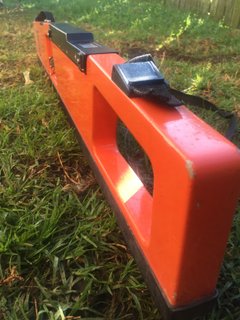Progress Update: Using an EM38 for moisture measurement at Black Earth Agronomy
Over the last few years, we have been engaging in extensive trials using an electromagnetic device called an EM38 to measure moisture levels in the soils around Cecil Plains, Norwin and Brookstead. After working with Jenny Foley in collaboration with the DNRM as part of the CRDC funded project NRM1401, I believe we are finally reaching the point where our results are accurate and reliable enough to assist with decision making.
I’ll elaborate in another article as to how we have achieved this but in this article I will discuss the potential uses and applications for this technology.
In the Fallow
One application that I am sure everyone will be interested in is that of fallow moisture measurement. After soil calibration, Black Earth Agronomy should be able to walk into any section of a field and quickly ascertain plant available moisture levels for depths 0 - 75cm and 0 - 150cm. This means that it will no longer be necessary to run around a field with a push probe making rough guesses as to the underlying moisture.
Another application in fallow fields may be to use the EM38 along with APSIM modelling software (CSIRO) to determine potential yields for a range of crops under a variety of possible seasonal weather conditions. This would enable us to determine whether it was better to plant immediately or leave the field fallow until sufficient moisture has been accumulated in the soil profile to achieve a target yield. We could also use potential yield data along with gross profit margins to find the most valuable and viable cropping options for that part of ground at that particular time.
Irrigations Scheduling
The EM38 is going to be particularly useful for deciding when to irrigate. The EM38 can give us accurate information about a field's overall moisture deficit allowing us to anticipate and act upon deficits in a similar way to what we already do with the Neutron probe. Unlike the Neutron probe, the EM38 allows us to measure anywhere in the field because an access tube is not necessary. If a particular measurement location does not appear to be representative of the field, we can easily adjust that location.
Infield water use
Another potential use of the EM38 is to measure moisture levels before and then directly after irrigation to determine exactly how much water was actually applied to the field. This would not only allow you to determine your $/L but would also allow you to determine what water losses are occurring between the dam and the field.
Soil Variability Mapping
Soil variability and salinity mapping using the EM38 has been extensively used in other regions and could find some use in some circumstances on the Darling Downs. At this time we don’t have the software and equipment to accomplish this but this could change based on interest levels.
Other more speculative uses
There are a number of other potential uses that have not been fully tested at this stage.
One such use would be to determine the length of water logging events in different parts of the field and then using this information to limit water logging in future irrigation events.
Another potential use is to measure compaction within a field. This would allow us to measure the impact of different forms of traffic of the field so as to limit compaction in the future.
Conclusion
The soil calibrations for the EM38 should be up and running by the upcoming 2016-17 summer cropping season which means that many of these applications above will be available for use. If anyone would like a demonstration of the EM38 or would like to discuss possible uses on your farm please feel free to contact me on 0428 615 711 or at [email protected].
Written by Robert Boulton
The information provided above is based on experience and knowledge developed while operating as an Agronomist on the Darling Downs. The opinions contained within this post are entirely that, and may not apply to a grower's specific circumstance. We recommend consulting your own agronomist to ensure best performance on your own farm.

